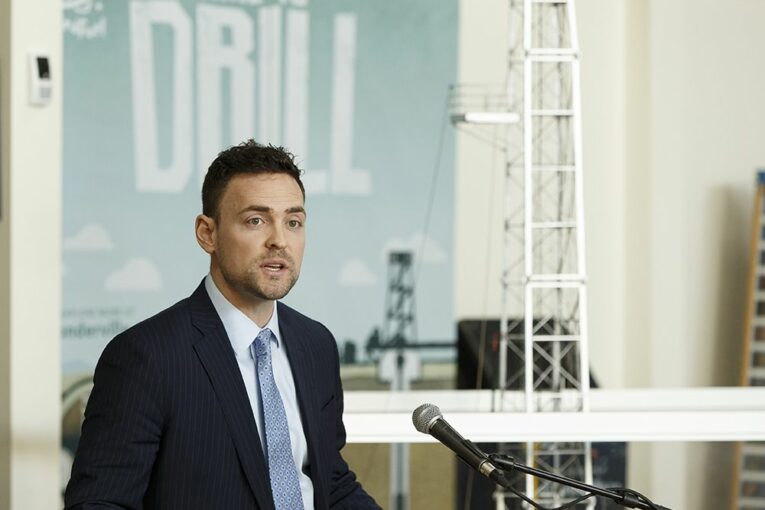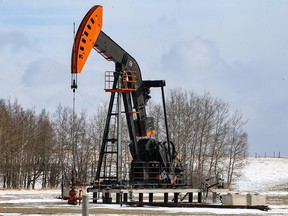
[ad_1]
What a difference 122 days — and oil above US$110 a barrel — can make.
Canadian oil and gas drillers gathered at the Calgary Petroleum Club on Friday for the annual luncheon of the Canadian Association of Energy Contractors (CAOEC), with a more bullish mood prevailing than when they last congregated in the same spot in late November.
“When you first walked in, did you not see a whole bunch of people smiling? It’s a much different environment today,” Duncan Au, chief executive of CWC Energy Services, said after the sold-out event concluded.
“Our company is well on its way to having a fantastic year.”
Four months ago, the CAOEC met to release its annual drilling forecast, which projected a moderate rebound in such activity for 2022 after 18 tumultuous months.
On that morning, benchmark oil prices hovered around $78.50 a barrel. Association president Mark Scholz projected a 27 per cent increase in the number of wells to be completed this year, but still below levels seen in 2018.
It was, however, a “message of hope” for a sector pushed to the brink during the early days of the pandemic, he said at the time.
Oil prices have soared in recent weeks, closing Friday at $113.90 for West Texas Intermediate (WTI) crude. Benchmark U.S. natural gas prices inched up Friday to $5.61 per million British thermal units.
Russia’s brutal invasion of Ukraine has ignited concerns about energy security around the world. European countries are trying to shift off importing Russian oil and gas. Canada and the United States have already declared such bans.
Today, the Trudeau government is touting the Canadian industry can increase oil and gas exports by about five per cent, adding up to 300,000 barrels of oil equivalent (boe) per day of production during the year to fill some of the gaps.
“Over four years, we have seen a lot of change and a lot of upheaval, and now it’s something completely different,” Saskatchewan Energy Minister Bronwyn Eyre told the audience Friday.
“It’s certainly a time when energy security and independence and affordability have (been) put in a whole new light, a real Technicolour focus.”
Like Alberta, Saskatchewan saw its oil production — sitting around 500,000 barrels per day in March 2020 — plummet during the early stages of the COVID-19 crisis. Provincial oil production is expected to average about 90 per cent of pre-pandemic output this year.
To add production, however, means the oilfield services sector needs to step up, providing equipment and expertise to make it all happen.
And it is.
According to the CAOEC, 190 drilling rigs were working last week as spring breakup arrived — out of a total fleet of 462 — an 80 per cent increase from a year earlier.
The Alberta Energy Regulator reports 1,668 wells were drilled in the first two months of the year in the province, a 40 per cent jump.
“Industry came out with a forecast and it took really two months for us to basically take that and throw it out the window,” Scholz said in an interview Friday.
“Certainly the demand for oilfield service equipment is a lot more robust than we had ever considered.”
Au noted all of CWC’s available drilling and service rigs are booked up. The company could add another 100 to 150 workers immediately, if they were available.

Prostar Energy CEO Dale Dusterhoft believes the sector is experiencing “controlled whiplash” as conditions have reversed quickly, although petroleum producers are maintaining more financial discipline than in past upturns.
As oil prices continue to climb, drilling new wells will become more profitable for producers, making the economics too attractive to ignore and leading to higher spending.
“I call it a controlled increase, but saying that, if you look at November until now, it’s been getting a little more — not frenzied — but a little more (busy) all the time,” Dusterhoft said.
There’s growing confidence in higher energy prices on both sides of the border. A survey released this week by the Federal Reserve Bank of Dallas found U.S. oilpatch executives expect WTI crude prices to sit at $93 a barrel by the end of this year.
There will be constraints on just how quickly the industry can add production, given limitations on equipment and labour shortages. Inflation is also beginning to bite and rates in the oilfield services sector are going up.
“The latter part of the year is going to be even more exciting in terms of what we’re going to see for activity,” said Scholz.
Canadian energy services stocks have also been climbing this year, punctuated by shares in Precision Drilling Corp. up 87 per cent and Ensign Energy Services rising by 70 per cent.
“Overall, it is probably the best outlook I’ve ever seen in 10 years,” said John Gibson, an industry analyst at BMO Capital Markets.
“Twenty-four months ago, everyone was leaving the sector for dead and now it’s becoming attractive from an investment standpoint over the longer term.”
One key growth factor going forward will be to ensure there’s enough stability to draw workers back into the sector after a painful seven-year downturn.
The Canadian industry, which drilled more than 13,000 wells the last time oil traded over $100 a barrel in 2014, completed just over 5,000 wells last year.
It will easily eclipse that figure this year as the outlook improves, bolstering sentiment across the sector.
“The good times are back but I would say that this time around, it’s different in the sense that I believe it’ll be much more sustainable,” added Au.
“We’re just going to have a steady or paced trajectory upwards — and that’s a good thing.”
Chris Varcoe is a Calgary Herald columnist.
[ad_2]
You can read more of the news on source
